Planning a vacation should spark joy, not stress. For travelers with mobility challenges or disabilities, the idea of navigating airports, hotels, and sightseeing spots can feel overwhelming—but it doesn’t have to be.
Thanks to evolving global awareness and improved infrastructure, accessible vacations are more abundant, adventurous, and inclusive than ever before. Whether you’re traveling solo, with family, or in a group, barrier-free travel is not only possible, but packed with potential.
This guide spotlights some of the best destinations, tips, and resources for creating an unforgettable, inclusive getaway.
Why Accessible Travel Matters

Accessible travel isn’t just about ramps and elevators. It’s about dignity, freedom, and inclusion. Everyone deserves the chance to explore the world without limitations based on physical ability. From wheelchair users to travelers with vision or hearing impairments, modern travel providers are recognizing the importance of creating environments that serve all guests equally.
Accessible travel matters because it ensures:
- Independence and safety
- Equal access to adventure and culture
- Peace of mind for travelers and their loved ones
Top Accessible Destinations Around the World

Here’s a curated list of accessible vacation spots that shine with inclusivity and thoughtful design:
1. Barcelona, Spain
A pioneer in accessibility, Barcelona has wide sidewalks, step-free metro stations, and accessible beaches with sand-friendly wheelchairs. Gaudí’s Sagrada Familia even offers elevator access to its towers.
2. Orlando, Florida
Theme parks like Walt Disney World and Universal Orlando are impressively inclusive, offering wheelchair rentals, accessible rides, quiet rooms, and trained staff to assist guests with all kinds of needs.
3. Sydney, Australia

Sydney combines city exploration with stunning natural beauty. Wheelchair-accessible ferries, beaches, and cultural institutions make it one of the most disability-friendly cities in the Southern Hemisphere.
4. Amsterdam, Netherlands
While many European cities are difficult for wheelchair users, Amsterdam is an exception. Its flat terrain, accessible canal cruises, and modern tram system are ideal for inclusive travel.
5. Vancouver, Canada
Known for its progressive infrastructure, Vancouver boasts scenic trails, accessible public transport, and top-notch adaptive adventure experiences like kayaking and mountain biking.
Cruise Your Way to Comfort

Cruises are often a top choice for travelers with limited mobility or disabilities. Major cruise lines like Royal Caribbean, Celebrity Cruises, and Princess have invested heavily in accessibility. Look for:
- ADA-compliant cabins
- Wide doorways and roll-in showers
- Onboard medical assistance
- Shore excursions adapted for all mobility levels
Accessible cruises take the worry out of travel by combining comfort, entertainment, and exploration in one inclusive package.
Beach Vacations Without Barriers

Love the beach but dread navigating the sand in a wheelchair? Many coastal destinations now offer beach access mats, amphibious chairs, and lifeguard support.
Top accessible beaches include:
- Santa Monica State Beach (California): Offers beach wheelchairs and accessible paths.
- Siesta Key Beach (Florida): Provides Mobi-Mats and staff assistance.
- Bondi Beach (Australia): Known for its beach wheelchairs and fully accessible surf programs.
Stay Smart: Choosing Inclusive Accommodations

When booking hotels, always check for:
- Roll-in showers and grab bars
- Elevator access and automatic doors
- Beds at appropriate heights for transfer
- Accessible parking and entrance routes
Apps and platforms like Booking.com, AccessibleGO, and Airbnb’s accessibility filters can help travelers identify the best barrier-free stays.
Tip: Always call the property directly to verify the accessibility features listed online.
Adaptive Adventure Activities

Just because you have mobility limitations doesn’t mean you have to skip the adrenaline rush. Try these adaptive adventure activities:
- Ziplining in Costa Rica with safety harnesses and assisted platforms
- Adaptive skiing in Colorado or Utah with trained guides and sit-skis
- Scuba diving with Diveheart, a nonprofit offering inclusive diving programs
- Paragliding in Interlaken, Switzerland, with specially trained tandem pilots
Transportation and Transit Tips

Getting from point A to B is a huge part of travel. Here’s how to make it smooth:
- Request assistance at airports in advance—most provide escort service, priority boarding, and wheelchair-friendly shuttles.
- Use ride-share apps that let you request wheelchair-accessible vehicles.
- Consider renting a scooter or portable ramp if your itinerary includes a lot of movement.
- Look for cities with accessible public transportation, including low-floor buses and subway elevators.
Planning Resources for Accessible Travel

There are excellent tools to help plan a stress-free, disability-inclusive vacation:
- WheelchairTravel.org: Honest reviews from a wheelchair user’s perspective
- AccessNow: Crowdsourced app that maps accessible locations
- AbleThrive: Offers curated content for adaptive living and travel
- Society for Accessible Travel & Hospitality (SATH): Advocacy and support resources
Working with certified accessible travel agents can also simplify planning and guarantee a smoother experience.
Tips for a Smooth Journey

Here are some bonus travel tips for a seamless experience:
- Always carry medical documentation and prescriptions.
- Pack extra medical supplies in case of delays.
- Notify airlines and hotels in advance of your specific needs.
- Travel with a companion if you require personal assistance, or request caregiver support through a provider.
- Be assertive and clear about your needs—you deserve a vacation without compromise.
The Future of Inclusive Travel

The future is bright for inclusive, accessible tourism. As more destinations embrace universal design, we’re inching closer to a world where disability isn’t a barrier to adventure—it’s just another part of the story.
Travel companies, governments, and everyday travelers are learning that accessibility benefits everyone—families with strollers, elderly travelers, people with temporary injuries, and more. Inclusion is not just right; it’s smart.


